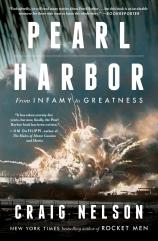Pearl Harbor: From Infamy to Greatness
Review
Pearl Harbor: From Infamy to Greatness
PEARL HARBOR is being published in anticipation of the 75th anniversary of the Japanese invasion of the naval outpost on Oahu, Hawaii, on December 7, 1941. A hefty tome that took five years of research, it provides an exhaustive account of the events leading up to and the aftermath of what has been called “the worst defeat in American naval history.” What author Craig Nelson has also provided readers with are insights into how the Japanese decided on and planned for this audacious undertaking --- and how many warnings the United States ignored, right up until the last moment.
"Undoubtedly, we will read many stories about Pearl Harbor in the coming months, but this book is an invaluable resource for those who want to know the whole story."
Going back to the mid-19th century, the author traces Japan’s evolution from an insular tradition-bound cluster of islands to a global player and, in the 20th century, a military juggernaut. In fact, the military’s role became so dominant that by the 1930s it was effectively a military dictatorship. By 1940, Japan, now an ally of Germany and Italy, had already conquered vast areas of China and was invading other parts of Asia. Even the Emperor had no real clout (and, as became evident, no spine). Yet, as the army and navy assumed dominance, Prime Minister Hedeki Tojo (who had served in the military) also claimed to have had misgivings about going to war. If, he later said, President Roosevelt’s last conciliatory telegram (which arrived the night before the invasion) had only come a few days earlier, everything would have turned out differently. However, Emperor Hirohito later told General MacArthur that if he had not approved of going to war, the army would have engineered a coup.
Craig Nelson, who has written a half-dozen well-received histories and biographies, has no desire to be a wholly impartial narrator. He interjects his confusion about Japan’s move to violence and aggression in the 1930s, as well as its motives in attacking the US and its contemporary attitudes toward that era. His visits to the country are documented, as are his trips to Hawaii, and interviews with survivors are referred to often. This brings to the book a welcome perspective, and heart, that keeps the reader engaged.
Though much of PEARL HARBOR focuses on political and military maneuverings, Nelson talks about the chilling effects that the invasion, and subsequent declaration of war, had on Japanese Americans, and especially those living in Hawaii. (Half of the Oahu population was at that time of Japanese ancestry.) He writes of the immediate panic that all those of Asian descent experienced, and how what happened to Japanese Americans at the internment camps and after justified their deepest fears.
Undoubtedly, we will read many stories about Pearl Harbor in the coming months, but this book is an invaluable resource for those who want to know the whole story.
Reviewed by Lorraine W. Shanley on September 23, 2016
Pearl Harbor: From Infamy to Greatness
- Publication Date: August 1, 2017
- Genres: History, Nonfiction
- Paperback: 544 pages
- Publisher: Scribner
- ISBN-10: 1451660502
- ISBN-13: 9781451660500





